 |
 |
| Home | Welcome | What's New | Site Map | Glossary | Weather Doctor Amazon Store | Book Store | Accolades | Email Us |
 | |||||||||
Weather Almanac for December 2001VICTORIA'S GREAT SNOWFALL
Tee shirts do not often commemorate weather events, but the new year of 1997 brought a brisk sale of tee shirts in Victoria, British Columbia. They proudly stated in a variety of colours and phrasings: "I Survived The Blizzard of ‘96." And while many (including me) might argue this storm was neither a blizzard nor a disaster, the snows that blanketed Victoria and surrounding regions with more than 150 cm (60 inches) of chilly white from December 21 to early January put many residents of southern Vancouver Island into an uncomfortable survival mode. When the first flakes began to fall on the morning of December 21, 1996, I was only concerned about my son cycling to work, but he had cycled in winter in Ontario many times and assured me he did not think much about it. But as the day progressed, the snow continued to fall heavily. Large, wet flakes that quickly built up a snow duvet 20-30 cm (8-12 inches) thick by sunset. At the end of the day, my thoughts leapt at the prospect that we might have a white Christmas (usually only a six percent probability), but, I live in that Canadian climate anomaly known as Victoria. Thus with lawns rejuvenated by the wet snow more than harmed by it, Christmas Day dawned a lush wintergreen. The next day, my annual ritual, a Boxing Day run, gave me wet but unfrozen turf and chip on the golf course perimeter trail with only glimpses of snow, small drifts cowering from the sun deep within the blackberry brambles. Little did I know the weekend surprise that would soon emerge. Waking on the morning of December 28th to the sounds of surprise on the street below, we were greeted with a white visage beyond window panes covered in dripping condensation. The predicted snow had fallen overnight, and the cityscape outside my windows was a winter wonderland. By mid-afternoon, however, the snow continued to fall and fall heavily. Every cloud that rolled over us was pregnant with this unusual solid white water and more than willing to litter all over the landscape. 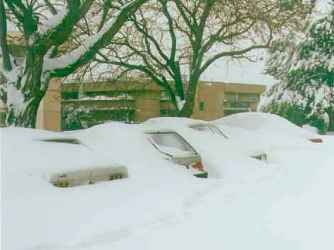 The prime players in this storm event came from quite different neighbourhoods. One of the usual series of Pacific winter storms brought very moist air from the subtropical regions, a flow regime know here as the Pineapple Express, across Washington State, over the Olympic Mountains and onto southern Vancouver Island. At the same time, a huge pool of frigid arctic air from northeastern Asia, known as the Siberian Pipeline, flowed across the extreme northwestern continent heading southward. The cold air over southern interior British Columbia broke through the coastal mountains and flooded over the Strait of Georgia, a frigid tide moving onto Vancouver Island. Express met Pipeline somewhere over the Victoria region. The result was not the usual heavy winter rain but unusually heavy, wet snow as the moisture bands from the Pacific storm collided with the escaping arctic blast. We whiled away the evening hours mesmerized as the snow poured unceasingly forth from the low-hanging clouds and buried most surface details below our windows. The forecast called for continued heavy snowfall overnight, but I do not think we understood what was in store that night as we snuggled into warm beds for our winter night's nap. 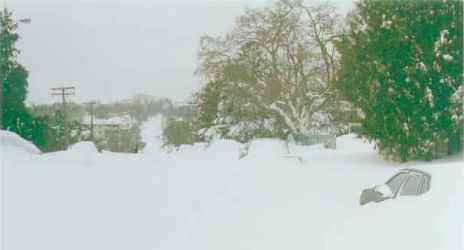 When my mind came to consciousness in the pre-dawn hours, I was shaken by something eerie in the darkness. What was that?....Silence!?! Normally, traffic and city buses on the streets below tell me morning is nigh. But this morning, nothing outdoors broke the acoustic peace. When morning dawned, the coastal city of Victoria was literally drowning in a sea of snow. The snow fell on cedars, Douglas firs, arbutus and Gerry oak alike. The streets were uniform covers of white broken only by human tracks. Most of the cars in the apartment parking lot were, well, gone from sight, only oddly shaped mounds hinted at their continued presence. 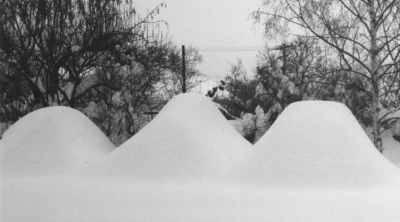 Here in Victoria, snowfalls above 10 cm (4 inches) are rare, and in this situation, Mother Nature had taken the upper hand. Victoria has few snowplows (five at the time), and most are attached to the centre of dump trucks, a viable method of snow removal in the normal light snows, but of no use in deep snow accumulations. 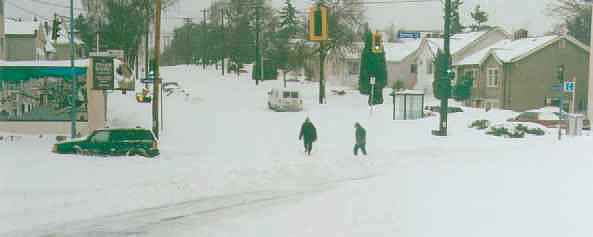 By the time the snow had tapered to a few flurries and changed to light rain, the snowfall officially measured a two-day total of 124 cm (48.8 inches) on December 28-29 and a 24-hour snowfall of 64.5 cm (25.4 inches) for the 29th, both local records. 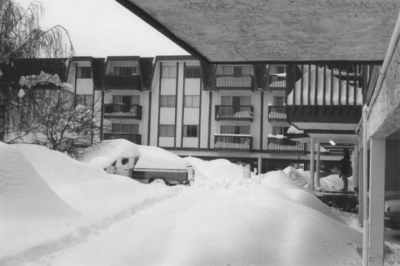 The local media called it the Blizzard of 1996, although with heavy snowfalls so rare here, The Blizzard would have sufficed. (The last major snowstorm of comparable size struck in 1917.) The rest of Canada had a rare opportunity for "reverse-gloating" when they heard the news -- Victorians can be rather smug about their mild winters and take every chance to rub it in to the rest of the nation. The media also called it a "disaster," but that, in my opinion was an exaggeration. If the storm was to be considered a disaster, it would be for its impact on many local buildings. Damage and clean-up costs were pegged at around $200 million Canadian dollars. Insurance claims of $120 million were the largest for a single event in British Columbia history. 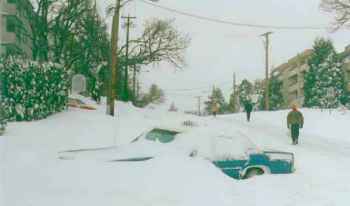 I term the event a transportation emergency since the accumulated snow prevented people from going where they pleased. Even four-wheel drive vehicles could not negotiate the deeply covered streets. The hardy took to walking or skiing. Not only did surface mechanized transportation stop, but Victoria International Airport and the BC Ferry service to the mainland and surrounding Gulf Islands also ground to a standstill. Staff could not reach the terminals nor could passengers get to or from the airport and ferry terminals. 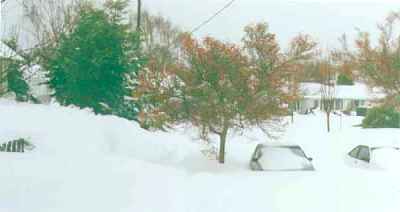 Boating was possible if you could get to one, but before you could embark, the decks had to be shovelled free of the heavy snow to avoid capsizing. Many boats were trapped and often damaged when the protective boathouses collapsed under the immense weight of the snow. The various levels of government (Victoria is the Provincial capital) were slow to react to the gravity of the situation. As a result, a popular local radio station CFAX voluntarily undertook organization of the community response. The greatest concerns arose when emergencies occurred, since police, emergency vehicles and medical attention could not get to the site. 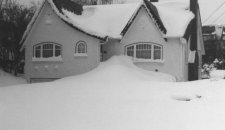 The overall reaction of the citizens of Greater Victoria was generally one of cooperation within neighbourhoods, offering what help could be delivered. Neighbours joined together to shovel snow from roof-tops, doorways, walkways and often complete streets. They shared food, medicines and other supplies. They offered companionship to those caught alone or frightened. Since snow in Victoria is so rare, many residents don't own a snow shovel so in lieu of the proper equipment, people used cake pans, plates, platters, baking sheets, dustpans, and cardboard boxes to create paths through the snow. Others just waded out and stomped trails into the snow. The storm wrought major damage to many buildings and utility structures around the region as the weight of the waterlogged snow collapsed roofs, sports bubbles, boat houses, carports and greenhouses. A number of boats sank under the weight of snow on deck, and several float homes capsized or sank. Many of the region's fragile greenhouses, private and commercial, were crushed under the burden of the snow, destroying not only the structure, but the crops growing within. 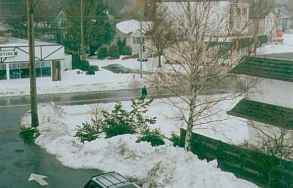 Just over a week later, the snow was gone, except where it had been piled in clearing roads and parking lots. Life returned to near normal, as did the weather. For a longer, more detailed account of the storm and its aftermath, see my article Victoria's Blizzard of '96 on the Weather Events page. For sixteen photographs of the snowscene near my apartment, see the Blizzard of '96 Photo Album. The odds of having a white Christmas Day are low here in Victoria (only a six percent chance) and as of this writing (December 10th), I have only seen an hour or so of flurries this winter. While I now keep my cross-country skis within easy reach (they were buried beneath a metre of snow on my balcony in 1996), I have had no occasion since 1996 to break them out. Perhaps this year. In any event, a Happy Holiday season to all and best wishes to all for a prosperous and peaceful New Year. All photographs by Keith C. Heidorn, ©2001Learn More From These Relevant Books
|
|||||||||
 |
To Purchase Notecard, |
Now Available! Order Today! | |
 |
 |
NEW! Now |
The BC Weather Book: |


